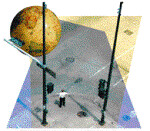Another of
Michael5000's
Forgotten Lands with maps by Cartophiliac.
Nova HiberniaCapital: N'koutou (formerly St. Patrick, Karlsburg)
Population: 1,443,000 (2000 estimate)
 Economy:
Economy: Produces cashews, cotton, sugar, citrus, timber, and fish. Imports include machinery and equipment, metals, staple foodstuffs, and textiles. Subsistence agricultural is practiced by a significant portion of the population.
The country of Nova Hibernia came into being in 1882 as the colony of German Central Africa. Like most other territories that were created by the Treaty of Berlin, German Central Africa contained a heterogeneous population drawn from disparate peoples who shared no common language, culture, or history. The Germans established a port at Karlsberg, but in their 30 years of rule did not manage to extend practical authority past its hinterlands. Stripped from Germany along with its other colonial possessions after World War I, the now nameless colony existed for several years as a League of Nations Protectorate. After several years of the British and French blocking each other's moves to absorb the little territory, administration was finally handed over in 1924 as something of a gift to the fledgling Irish Free State.

Absorbed in their own lengthy struggle for full independence, the Irish devoted little attention to their "overseas empire." As a result, the Irish administration had an even lighter footstep than had the German. Although adopting some Western innovations, most inhabitants of the newly-renamed Nova Hibernia tended to continue to live and govern themselves according to well-established indigenous systems. When a provisional government set up by native schoolteacher Brian Ktombe petitioned for and was granted independence by the Irish Parliament in 1963, the event failed to make the front page of the Irish Times.
Since independence, Nova Hibernia has suffered two periods of military rule, once for three months in 1969 and again from 1978 to 1984. Ktombe's nephew, Brian Ktombe III, became president in 1985 in elections that restored democratic rule. Since that time, he has been re-elected every six years in elections that, by the standards of sub-Saharan Africa, have been relatively free and fairly contested.
Nova Hibernia is also unusual in Africa in that it never acquired a large international debt. Instead, the country's political elite have long pursued a policy of small-scale local development and grassroots education. Perhaps not coincidentally, Nova Hibernia enters the third millennium with one of the continent's highest standards of living.
 Flag:
Flag: Older colonial banners, like the capital city's name, were replaced at independence. The new design was clearly inspired by the flag of the United States, the country on which Nova Hibernia's federal system was modeled. The ten colored stripes represent the ten federal districts, and the blue field represents the common blood* of all Nova Hibernia's people. Some have speculated that the lack of green, orange, or white in the flag suggests a rejection of all things Irish by the newly independant colony.
*In local tradition, blue is the color of "living blood" (as it is seen in the vein). Red represents "dead blood," and is generally avoided in decoration.Labels: africa, flags, forgotten lands, imaginary countries













 New Bretton is spared many of the Northwest Atlantic region’s economic woes due to the presence of New Bretton Scientific, a leading world manufacturer of precision optical equipment. Occupying a bluff overlooking the capital and only real town, the company’s production facility employs one of every five New Brettons, many in highly skilled and well-paid positions. Local entrepreneur Brian Redham founded the company in his basement in 1962, and is now thought to be comfortably among the world’s richest 100 people.
New Bretton is spared many of the Northwest Atlantic region’s economic woes due to the presence of New Bretton Scientific, a leading world manufacturer of precision optical equipment. Occupying a bluff overlooking the capital and only real town, the company’s production facility employs one of every five New Brettons, many in highly skilled and well-paid positions. Local entrepreneur Brian Redham founded the company in his basement in 1962, and is now thought to be comfortably among the world’s richest 100 people.










 Two more examples of maps and globes in magazine cover design.
Two more examples of maps and globes in magazine cover design. The current issue of
The current issue of 















